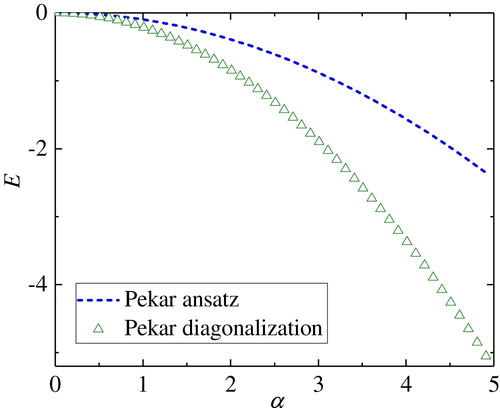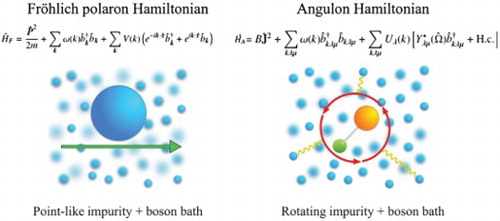Figures & data
Figure 1. (a) The polaron energy as a function of the Fröhlich coupling constant, α, for the Chevy ansatz, Equation (Equation4(4)
(4) ) (red solid line), coherent state on top of single phonon excitation, Equations (Equation12
(12)
(12) ) and (Equation16
(16)
(16) ) (black dotted line), and the Feynman variational method [Citation27] (orange dash-dotted line). (b) Renormalization of the polaron mass as a function of the Fröhlich coupling constant, α, for the Chevy ansatz (red solid line), coherent state on top of single phonon excitation (black dot line), and the weak coupling theory [Citation24] (purple circles). See the text (Colour online).
![Figure 1. (a) The polaron energy as a function of the Fröhlich coupling constant, α, for the Chevy ansatz, Equation (Equation4(4) ∣ψp⟩=Zp∣p⟩∣0⟩+∑kβp(k)∣p−k⟩bˆk†∣0⟩,(4) ) (red solid line), coherent state on top of single phonon excitation, Equations (Equation12(12) ∣Φp⟩=∣ϕ⟩⊗∣p⟩,(12) ) and (Equation16(16) ∣ϕ⟩=g∣0⟩+∑kα(k)bˆk†∣0⟩.(16) ) (black dotted line), and the Feynman variational method [Citation27] (orange dash-dotted line). (b) Renormalization of the polaron mass as a function of the Fröhlich coupling constant, α, for the Chevy ansatz (red solid line), coherent state on top of single phonon excitation (black dot line), and the weak coupling theory [Citation24] (purple circles). See the text (Colour online).](/cms/asset/12a5d0fb-1296-4982-a880-2dd1a6ff7fe0/tmph_a_1567852_f0001_oc.jpg)
Figure 2. The polaron energy as a function of the Fröhlich coupling constant, α, for the Pekar ansatz, Equation (Equation24(24)
(24) ) (blue dash line), and the Pekar diagonalisation technique, Equations (Equation29
(29)
(29) ) and (Equation33
(33)
(33) ) (green triangles). See the text (Colour online).

Figure 3. The angulon ground state energy as a function of the angulon coupling constant, α, for the Chevy ansatz [Citation17,Citation18] (red solid line), the Pekar ansatz [Citation35] (blue dashed line), and the Pekar diagonalisation method of Equation (Equation35(35)
(35) ) (green triangles). The basis consists of the vectors with j=0,1,2. See the text (Colour online).
![Figure 3. The angulon ground state energy as a function of the angulon coupling constant, α, for the Chevy ansatz [Citation17,Citation18] (red solid line), the Pekar ansatz [Citation35] (blue dashed line), and the Pekar diagonalisation method of Equation (Equation35(35) |Ψjm⟩=|jm⟩exp[−Xˆjm]|0⟩,(35) ) (green triangles). The basis consists of the vectors with j=0,1,2. See the text (Colour online).](/cms/asset/5459f028-eca5-496d-81ae-cab6aa88b4fb/tmph_a_1567852_f0003_oc.jpg)

